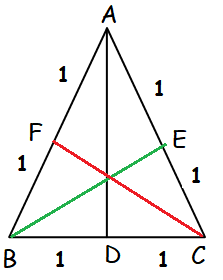DIRECTION COSINES WORD PROBLEMS IN VECTORS
Subscribe to our ▶️ YouTube channel 🔴 for the latest videos, updates, and tips.
Problem 1 :
A triangle is formed by joining the points (1, 0, 0), (0, 1, 0) and (0, 0, 1). Find the direction cosines of the medians.
Solution :
Let the given points be A (1, 0, 0) B (0, 1, 0) and C (0, 0, 1)
OA vector = 1i vector
OB vector = 1j vector
OC vector = 1k vector

AB vector = OB vector - OA vector
= (j - i) vector
BC vector = OC vector - OB vector
= (k - j) vector
CA vector = OA vector - OC vector
= (i - k) vector
Equation of median AD :
D is the midpoint of the line segment BC.
The median line AD divides the line segment BC in the ratio 1 : 1
AD vector = 1(AB vector) + 1 (AC vector) / (1 + 1)
= (AB vector + AC vector)/2
= (j - i) + (k - i)/2
= (-2i - j + k) vector/2
x = -2/2 = -1, y = -1/2 and z = 1/2
Direction cosines of AD :
r = √(-1)2 + (-1/2)2 + (1/2)2
r = √1 + (1/4) + (1/4)
= √6/2
x/r = -2/√6
y/r = -1/√6
z/r = 1/√6
Direction cosines of AD are (-2/√6, -1/√6, 1/√6).
Equation of median BE :
E is the midpoint of the line segment AC.
The median line BE divides the line segment AC in the ratio 1 : 1
BE vector = 1(BA vector) + 1 (BC vector) / (1 + 1)
= (i - j) + (k - j) / 2
= (i - 2j + k)/2
x = 1/2 , y = -1 and z = 1/2
Direction cosines of AD :
r = √(1/2)2 + (-1)2 + (1/2)2
= √6/2
x/r = 1/√6
y/r = -2/√6
z/r = 1/√6
Direction cosines of BE are (1/√6, -2/√6, 1/√6).
Equation of median CF :
F is the midpoint of the line segment AB.
The median line CF divides the line segment AB in the ratio 1 : 1
CF vector = 1(CA vector) + 1 (CB vector) / (1 + 1)
= (i - k) + (j - k) / 2
= (i + j - 2k)/2
x = 1/2, y = 1/2 and z = -2/2 = -1
Direction cosines of AD :
r = √(1/2)2 + (1/2)2 + (-1)2
= √6/2
x/r = 1/√6
y/r = 1/√6
z/r = -2/√6
Direction cosines of CF are (1/√6, 1/√6, -2/√6).
Problem 2 :
If 1/2, 1/√2, a are the direction cosines of some vector, then find a.
Solution :
Since the given are the direction ratios of some vector, it must satisfies the condition given below.
x2+ y2 + z2 = 1
(1/2)2+ (1/√2)2 + a2 = 1
(1/4) + (1/2) + a2 = 1
a2 = 1 - (1/4) - (1/2)
a2 = (4 - 1 - 1)/4 = 2/4 = 1/2
a = ±1/√2
Problem 3 :
If (a , a + b , a + b + c) is one set of direction ratios of the line joining (1, 0, 0) and (0, 1, 0), then find a set of values of a, b, c.
Solution :
Let the given points as A (1, 0, 0) and B (0, 1, 0)
OA = i vector and OB = j vector
AB vector = OB vector - OA vector = j - i
Direction ratios of AB vector = (-1, 1, 0)
By comparing the direction ratios with the given information, we get
a = -1 ---(1)
a + b = 1 ---(2)
a + b + c = 0 ---(3)
By applying the value of a in (2), we get the value of b
-1 + b = 1
b = 1 + 1 = 2
By applying the values of a and b in (3), we get c.
-1 + 2 + c = 0
1 + c = 0
c = -1
So, the answer is (-1, 2, -1) (or) (1, -2, 1).
Subscribe to our ▶️ YouTube channel 🔴 for the latest videos, updates, and tips.
Kindly mail your feedback to v4formath@gmail.com
We always appreciate your feedback.
About Us | Contact Us | Privacy Policy
©All rights reserved. onlinemath4all.com

Recent Articles
-
10 Hard SAT Math Questions (Part - 44)
Jan 12, 26 06:35 AM
10 Hard SAT Math Questions (Part - 44) -
US Common Core K-12 Curricum Algebra Solving Simple Equations
Jan 07, 26 01:53 PM
US Common Core K-12 Curricum Algebra Solving Simple Equations -
10 Hard SAT Math Questions (Part - 4)
Jan 05, 26 06:56 PM
10 Hard SAT Math Questions (Part - 4)
